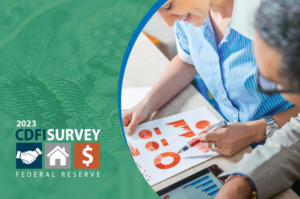 2023 CDFI Survey
2023 CDFI Survey
Federal Reserve
First published August 2023
Since 2019, the Federal Reserve has been surveying Community Development Financial Institutions (CDFIs) across the nation. Through the CDFI Survey, the Fed and survey partners seek to learn more about how these institutions, which serve financially underserved individuals and communities, are faring and evolving. To administer the 2023 survey, the Fed partnered with the CDFI Fund, Opportunity Finance Network, the CDFI Coalition, Inclusiv, the Community Development Bankers Association, the Native CDFI Network, First Nations Oweesta Corporation, NeighborWorks America, and several statewide CDFI coalitions and networks.
Survey results have shown that demand for CDFIs’ products and services has continually grown for years. In the 2019 survey, almost three-quarters of respondents said demand had increased from 2018. An even larger share (86%) foresaw demand continuing to increase in 2020. Although CDFIs’ business slowed briefly at the onset of the pandemic, the 2020 COVID-19 CDFI Survey revealed that the resulting economic environment spurred many financially underserved individuals and businesses to seek banking or lending services, and demand for CDFIs quickly regained momentum. As demand for their products and services continued to grow, CDFIs expressed wanting to offer additional products and services. In the 2021 survey, 76% of respondents said they wanted to expand their offerings but could not on a sustained basis. Limited staffing was frequently reported as a top inhibitor to growth. Lending capital was the secondary issue.
The 2023 survey, which was fielded from April 24 to June 2 and gathered information from 453 respondents (nearly a third of the industry), finds CDFIs again facing increased demand but in a different economic environment. Rising interest rates have pushed the cost of lending capital to the forefront as a challenge for many CDFIs. Meanwhile, the tight labor market and rising wage environment has added to previously reported staffing challenges and the need for operational funding. On the other hand, CDFIs have continued to innovate and have received unprecedented levels of federal funding and increasing congressional support. There are also growing examples of state-level support to CDFIs, including statewide CDFI coalitions and funding pools. What have the recent headwinds and supports meant for the ability of CDFIs to meet demand? And what does the road ahead look like?
Download Resource